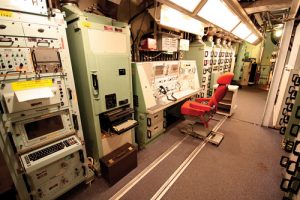Life in a Cold War missile silo: free lecture at the Relic Room
May 16, 2019How did it feel to be at the tip of the nuclear spear during the Cold War? Specifically, what was life like sealed up for 24-hour shifts in a missile silo, 60 feet beneath the earth?
Former Air Force officer Frank Shuler will answer those and other questions on Friday, May 31, at noon at the South Carolina Confederate Relic Room and Military Museum in Columbia. The free lecture, part of the museum’s Lunch and Learn series, is open to the public.
Shuler lived it, as an Air Force lieutenant in the 1980s. From October 1985 to November 1989, he was stationed at Grand Forks Air Force Base in flat, remote North Dakota.
Eight times a month, he would ride 2.5 hours from the base to his duty station, the LCF, or Launch Control Facility. Once there, he would undergo elaborate security checks before riding an elevator 60 feet down, where he and another man would be hermetically sealed into a capsule behind a blast door – which had to be gradually, manually pumped open hydraulically, then just as laboriously closed.
There, with a sidearm on his hip, a safe full of launch codes and a key – one that wouldn’t work unless his partner’s key was used at the same time – he would sit and wait for the moment that, fortunately for the human race, never came: the order to launch Armageddon.
Not that he had nothing to do. It was his job to monitor his team’s 10 Minuteman II missiles. Each one had three independently targetable nuclear warheads, each of them with a 1.2 megaton yield, making each one as much as 100 times as destructive as the bomb dropped on Hiroshima.
As part of the redundancies built into such a high-stakes system, his team could also see the 10 missiles in another silo miles away. “Say I’m at Alpha Zero,” Shuler says. “I could also monitor Bravo Zero.”
The men in this unit watched each other in more personal ways as well. Under the Personal Reliability Program, or PRP, “Everybody’s kind of looking at everybody else,” he said. And it was each man’s duty to reach out to the proper authorities if a comrade looked like he needed some sort of intervention – for drug or alcohol issues, or some other problem indicating instability.
Any behavioral change could be a concern. “I always liked the guys I was with,” he remembers, but “There were some people always in a bad mood.” That was OK. But “If they were happy, that was a concern.”
It was tense duty, for a lot of reasons. Here’s one: The silos had been dug to their 60-foot depth back in the ’60s. By the mid-’80s, a Russian warhead could create a 250-foot crater. This instilled a certain fatalism. The silo crews would joke, “You’ll die from the fall to the bottom of the crater.”
During training for such duty, each man was not only screened for whether he could get along with another person sealed up in a small space, but for the answer to the big question: “Can you do this?”
“You’re talking about killing a bunch of people,” says Shuler. “I mean, millions and millions of people.”
“I never had any doubt,” he says. Growing up as an Air Force brat, he had a clear sense of his duty. His father is E.G. “Buck” Shuler Jr., who as a lieutenant general once commanded the storied Eighth Air Force (and who spoke at the museum for a previous Lunch and Learn program). Sometimes, son Frank knew his Dad was aloft in Looking Glass, the airborne platform from which the missiles he himself watched could be fired remotely if necessary.
After his stint in the Air Force, Frank Shuler went to law school. He practices in Sumter, S.C.
About the South Carolina Confederate Relic Room and Military Museum
Founded in 1896, the South Carolina Confederate Relic Room and Military Museum is an accredited museum focusing on South Carolina’s distinguished martial tradition through the Revolutionary War, Mexican War, Civil War, Spanish-American War, World Wars I and II, Vietnam, the War on Terror, and other American conflicts. It serves as the state’s military history museum by collecting, preserving, and exhibiting South Carolina’s military heritage from the colonial era to the present, and by providing superior educational experiences and programming. It is located at 301 Gervais St. in Columbia, sharing the Columbia Mills building with the State Museum. For more information, go to https://crr.sc.gov/.


















